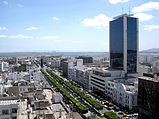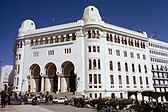Maktarim
This article is incomplete because it is pending further input from participants, or it is a work-in-progress by one author. Please comment on this article's talk page to share your input, comments and questions. Note: To contribute to this article, you may need to seek help from the author(s) of this page. |
New Aɣmat City
Azaɣar Aɣmat n Assa | |
|---|---|
Capital | |
Clockwise from top left: Downtown at the Waterfront, preserved ruins in Old Aɣmat, a night market in Tetsouiq Garden, electric bus rapid transit lanes in the Laqbilt Quarter, a beach in the Laɣrab Quarter, and Place Messidor/Adɣar Mgrawi in Murabbaɣ Centre | |
| Country | Messidor Union |
| Nation | Aɣmatia |
| Province | New Aɣmat |
| Neighbourhoods: | List
|
| Founded | c. 3800 BCE (Old Aɣmat) 1513 CE (New Aɣmat) |
| Government | |
| • Type | City council |
| • Body | New Aɣmat City Workers' Council |
| Area | |
| • Capital | 823 km2 (318 sq mi) |
| • Metro | 16,618 km2 (6,416 sq mi) |
| Highest elevation | 375 m (1,230 ft) |
| Lowest elevation | 0 m (0 ft) |
| Population (2018) | |
| • Capital | 8,873,785 |
| • Density | 11,000/km2 (28,000/sq mi) |
| Demonym | New Aɣmatian |
| Postal code | AAM-1000 to AAM-1499 |
| Area code(s) | 318 and 429 |
New Aɣmat City (Tamaziɣt: Azaɣar Aɣmat n Assa, Audonic: Cité de Nouveau Aɣmat) is the capital and largest city of the Messidor Union with a population of 8,873,785 as of the 2018 census. It is located in the constituent nation of Aɣmatia on the coast of Juga Bay in the Periclean sea.
The city proper extends 823 km2 (318 sq mi) but its metropolitan area extends approximately 16,618 km2 (6,416 sq mi). Density outside the city centre is relatively low, however, the metropolitan area is served by one of the most efficient intra-city transit systems in the Messidor Union.
New Aɣmat City is a transportation and service hub. It is often considered the economic core of the Messidor Union. In addition, it is home to a number of culturally significant monuments and festivals.
History
New Aɣmat City has a history that stretches millennia, generally divided into two eras. The first era stretches from the city's founding in the early fourth millennium BCE until its destruction following the Great Earthquake of Gran Aligonia in 1440. The second era began with the reconstruction and founding of "New Aɣmat" and extends to the present day.
Old Aɣmat
The site of Old Aɣmat is one of the oldest urban centres in the Messidor Union. Signs of nomadic life in present-day Aɣmatia date to the sixth millennium BCE. Permanent settlements and small villages appeared in the hills in the fifth millennium, centred on fresh water rivers. The population of the Amaziɣ peoples known as the Kel Adrar began to settle upon the coasts by the beginning of the fourth millennium. The date of Old Aɣmat's founding is uncertain and there are no definitive contemporary accounts. The records of the third millennium, mostly through the religious texts and histories of Itmassan-ddin already regarded the settlement as an ancient city.
Major upheavals in the city's history included its annexation by the ancient Aradians in the second millennium BCE. The Kel Adrar tribes that were settled in the old city became a client state of the mercantile empire and flourished while preserving their culture and religion. While the Aradians began to decline, Old Aɣmat remained a vital trade gateway after emerging from its client state status and confederating with the Tamazɣa in the early fifth century BCE. Trade goods and luxuries were routed from southern Scipia up through the Ninva desert in what is modern-day Charnea and were diffused through the Periclean via the port of Old Aɣmat.
In the second century BCE, the Latin Empire's campaigns in northern Scipia reached the Kel Adrar. The city was conquered by the Latins in 153 BCE and it was incorporated as the capital of a new province, called Armatica, which extended along the coasts of present-day Aɣmatia. The Latin rule over the Kel Adrar was more strained and was frequently challenged by the Amaziɣ clan leaders. In 320 CE, Fabrian Christianity became the state religion of the Latin Empire. Local Christians and Nazarenes had frequently clashed with the rest of the population over their rights to worship. The first church, constructed in 299 CE, was burned down within the year. The adoption of the state religion led to riots. A full-scale revolt was put down by a Latin legion, but the governors maintained a heavy military presence for generations to come.
In the late ninth century CE, missionaries arrived in Old Aɣmat to preach the teachings of Mubashir and the Azdarin faith. Warriors followed, led by Ambelo Qallu, and they conquered Armatica. Ahmad ibn Zahir al-Huwali, an adherent of the Sahb sect, was appointed to govern the region and founded a new capital named Avana away from the coast. Over time, Old Aɣmat became a centre for the 'lifae faith as converts and syncretists remained more comfortable with the open ocean on the horizon. While the capital was located in a fortress to the south, Old Aɣmat remained the commercial and economic heart of the governate.
The First Crusade in the thirteenth century and war with the new Most Magnificent Republic of Aligonia in the fourteenth century saw a decline in the city's fortunes. However, the most cataclysmic event was the Great Earthquake of 1440 which rippled through the central Periclean. Ripples and aftershocks from the earthquake destroyed many buildings in the city while tidal waves destroyed fisheries and the old waterfront. Fires broke out in the aftermath and burned down a significant portion of the remaining city. After a few months, over three-quarters of the city lay in ruin, including ancient temples and monuments which dated back millennia.
New Aɣmat
The ruins of the old city lay in disarray for over half a century. Initially, lawlessness took over as the elite and great numbers of the Kel Adrar clanspeople fled the destruction. By 1500, however, the city was de facto ruled by a few remaining clans. After Malik Izîl seized power and formed the Mamlakat al-Akhmat in 1513, he sought to restore the mercantile capital of his new country, even though the court remained in the fortified citadel of Avana.
The first part of the reclamation of the city was to restore order. Soldiers patrolled the streets and arrested clanspeople who defied the new caste system and restored property to the Muqtis. The second part was reconstruction. Materials for the new city were salvaged from the previous ruins, including ancient monuments, some of which remained relatively untouched from the earthquake before the reconstruction began. The new city had a stricter grid layout than its predecessor, designed to separate different castes and trades from one another. The harbour was also made more defensible and accommodations were provided to garrison a standing army.





